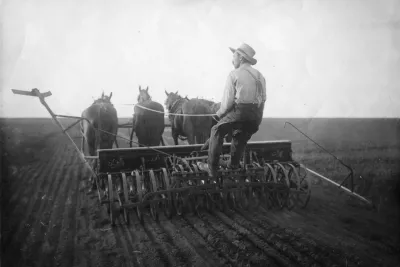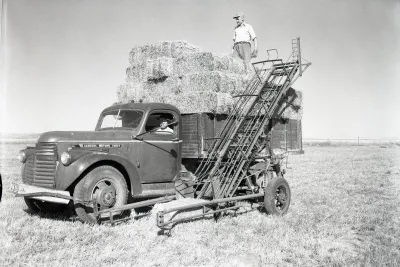Homesteading
History and Background
To encourage settlement in Western Canada, the Dominion Government offered a grant for a free homestead of 160 acres (also known as a quarter-section) for a $10 registration fee to those individuals and families who were prepared to live on and cultivate the land during a qualifying period of time. Millions of people from around the world flocked to the Canadian prairies to take advantage of these land grants.
The homestead process began with entry, which is a term that was used to describe the act of going to a Dominion Lands office and filing for a claim to a particular parcel of land or "homestead".
Source for historic information about homesteading: Kirk Lambrecht’s The Administration of Dominion Lands, 1870-1930 (Regina: Canadian Plains Research Center, 1991.)

Seeding on the farm of A.W. Laudner near Govan, SK in the early 1900s.
PAS Photo R-A113.
Eligibility
Settlers could only obtain entry to a homestead quarter section if they met certain eligibility requirements:
Before 1874: Initial age requirement was a minimum of 21 years.
1874: Age requirement was dropped to 18 years but if you were younger and already head of a family, you could make entry.
1876: Women were eligible to enter only if they were the sole head of family.
1908: Settler must be or declare an intention to become a British subject

Loading bales of hay at O.A. Williamson farm, north of Ponteix, 1956. Photographer: Ralph Vawter. PAS series S73 no. 56-228-002.
Required Duties or “Proving Up” the Homestead
Once in Saskatchewan and on their chosen quarter section of land, settlers had to meet certain obligations before the patent – or ownership – of the land was transferred from the Crown to the homesteader.
The process of fulfilling the duties was referred to as "proving up" the homestead:
1872 (original Dominion Lands Act)
- The settler must cultivate and reside on the land for three years.
1884
- The settler must build a habitable house.
- The settler must live within a radius of two miles from the homestead.
- Within the first year after date of entry, the settler must break and prepare to crop no less than 10 acres of the homestead quarter section.
- Within the second year, the settler must crop the first ten acres and break and prepare to crop no less than 15 more acres.
- Within third year after date of entry, the settler must crop the 25 acres broken in the first two years, and break and prepare for crop no less than 15 more acres.
- The settler must reside on the homestead for at least six months of the year in each of the three years.

Humboldt telegraph office and mail station, 1885. PAS Photo R-B11834.
1886
- The settler must commence cultivation of their homestead within six months of date of entry or, if entry was obtained on or after the first day of September in any year, before the first day of June following.
- Within the first year after entry, the settler must break and prepare for crop no less than 5 acres.
- Within the second year, the settler must crop the initial 5 acres, and break and prepare for crop no less than 10 additional acres.
- The settler must build a habitable house before end of second year and at the beginning of the third year must commence residence on homestead.
- The settler must give six months’ notice in writing to the Commissioner of Dominion Lands of his/her intention to make application for patent.
1908
- The settler must be a British subject.
- The settler may reside within a distance of nine miles of the homestead to count as residence.
1914
- The settler must enclose the whole quarter section being entered by a substantial fence.
- Any alien who has not resided in the British Dominions for the period necessary for naturalization shall be entitled to obtain letters patent for a homestead as if he/she were a British subject provided that he/she satisfies the Minister of the Interior that in all other respects save the period of residence that he/she is qualified to be naturalized.
1915
- Residence and cultivation duties waived for those whose injuries during service in the First World War made compliance with homestead duties impossible.
Pre-emptions
Pre-emptions were introduced in 1874 and allowed a homesteader to obtain a second quarter section of land adjacent to the homestead.
- The homesteader could receive the patent for the pre-emption by paying a fixed price for the land after receiving the patent for the homestead.
- Pre-emptions could be purchased up to 3 years after the homestead was patented and could remain unimproved for at least 6 years after the date of entry.
- This system was cancelled in 1890 and reinstated in 1908.
After an amendment to the Dominion Lands Act in 1908, pre-emptions could be made by any person who had obtained or intended to obtain an adjoining homestead entry.
- Resident requirements for the pre-emption could be satisfied by residence on the homestead.
- Cultivation requirements – 50 acres in addition to the homestead requirements – could also be satisfied on the homestead.
- Patent for the pre-emption could be obtained when a fixed price for the land had been paid by installments over eight years.
Purchased Homesteads
Purchased homesteads were available from 1871 to 1918. Under this system, a settler could purchase 160 acres of land within a nine mile radius of his or her homestead quarter. The price for the land was $3.00 per acre. A one-third down payment was required and the balance was to be paid in five equal installments.
